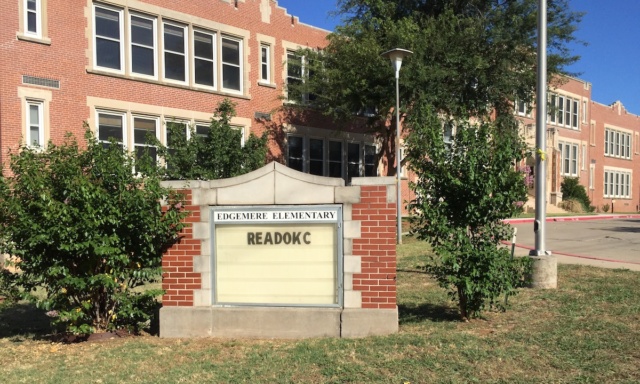
For a decade or more, when walking the dog from our home in Central Park to Edgemere Park, my wife and I witnessed one of the absurdities of NCLB test-driven incentives and disincentives: One way that the federal government punished the Oklahoma City Public School system was by forcing it to send a bus to transport one or two students who lived in the area to Quail Creek or Nichols Hills elementary schools.
These fortunate kids invariably lived in the affluent part of the “failing” Edgemere Elementary School feeder neighborhood. Middle-class and less-poor kids attended Putnam Heights, Horace Mann, Wilson or other elementary schools.
Now we see something that hasn’t happened for more than 30 years. We see middle-class kids, including white kids, walking to the David R. Lopez Community School at Edgemere. Parents no longer repeat a long list of complaints about the school. In addition to praising Edgemere in everyday conversations, parents and students filled the school cafeteria in support of their community school, arguing against its proposed closure.
Community effort causes transformation
Edgemere’s transformation is due to both the efforts of dedicated educators and their embrace of full-service community schooling. They adopted holistic, science-based policies that are the opposite of the teach-to-the-test approach that still undermines many or most of the OKCPS’s high-poverty schools. Edgemere educators embrace the overwhelming body of cognitive and social science which explains why we must address students’ physical, social, and emotional needs as we improve instructional capacity.
Even in this era of test-driven, competition-driven reform, school systems give lip service to the need to invest in building “social capital” and “relational trust.” As Chicago’s Charles Payne cryptically observes, however, principals are held accountable for often-meaningless test score gains. They frequently remain oblivious to the importance of trusting school cultures.
In other words, schooling must be a team effort. A long list of community partners contribute to Edgemere’s success. They help offer after-school and in-school academic and cultural opportunities, as well as dental, nutritional and mental health services. Volunteers include:
- Oklahoma Media Company
- Whiz Kids
- Wesley United Methodist Church
- Church of the Servant
- Regional Food Bank
- OKC Police Athletic Leagues
- First Christian Church
- Paseo Arts Association
- Community Literacy Centers
- Oklahoma Children’s Theatre
- OKC Harvest
- El Sistema Oklahoma
- Girl Scouts of Western Oklahoma
- OSU OKC/OK County Extension Center
- and Sunbeam Family Services.
‘Adults share responsibility for all children’s learning’
Two recent studies of community schools speak to the challenges faced by Edgemere and the OKCPS. A comprehensive analysis by Linda Darling-Hammond’s Learning Policy Institute and National Education Policy Center and an Edgemere 2016 Capacity Report by the University of Oklahoma Center for Education Policy explain what it takes to offer “deeper learning,” or the meaningful education which prepares kids for life after high school.
The national study, conducted by some of the nation’s greatest education scholars (including the Ford Foundation’s Jeannie Oakes) analyzed “125 studies of the impact of community school programs or pillars, including 49 reviews of research.” It concludes that well-trained, experienced teachers are essential to address poor children’s academic, social and health-related needs, “but so are teacher collaboration and learning. Adults share responsibility for all children’s learning.”
The first major success story that was reviewed was the Tulsa Area Community Schools Initiative (TACSI) that helped provide guidance to Edgemere. It reported:
Researchers compared outcomes in TASCI schools to outcomes in carefully selected non-community comparison schools. They found that fully implemented community schools produced significantly greater benefits for students. In schools that didn’t do a good job of implementing the model, the effects were less impressive. By the third and fourth years, students at fully implemented community schools scored significantly higher than their peers in other schools on standardized math and reading tests.
National researchers explained that the Tulsa success was in large part due to “a climate of trust among students, teachers, and parents [which] was a strong school-level predictor of achievement.” Academic gains often are a lagging indicator of progress, following reductions of absenteeism and misbehavior. Especially in schools where children bring mistrust of their peers to class, “the work is best accomplished when school and community representatives plan and work together, building a school culture that is collaborative and collegial.” Successful community schools need “sufficient planning time to build trusting relationships between the school and an array of service providers as well as parents and staff.”
Data from Edgemere
One-hundred percent of Edgemere teachers indicated teachers at Edgemere cared about and looked out for them. Ninety-four percent of parents reported that Edgemere worked with them to meet individual student needs, and 96 percent said the school does a terrific job.
The OU study notes that only 30 percent of the students “believe their peers are honest” and “46 percent of students believe students at Edgemere can depend on each other.” On the other hand, between 89 and 96 percent of students voice hopefulness about learning at school.
And that brings us to what I believe is the school’s next frontier: addressing the finding that only 26 percent of students come to the elementary school saying “they want to learn new things.”
Students learn from adults and peers who love them. They learn to learn from family, friends, and educators who they trust. Provide the safe, respectful and nurturing environment that community schools like Edgemere offer, and the percentage of children who want to learn new things will go through the roof.
At that point, Edgemere is likely to get the same great publicity as the Tulsa and Tulsa Union successes receive, making it more likely that the OKCPS will fully invest in community schools.





















